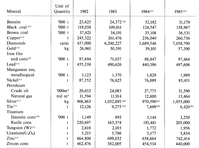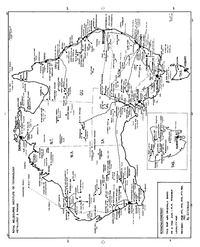


Chapter 10
I 1. Introduction
II 2. The Role Of Technology
III 3. Some Highlights Of Australian Minerals Technology
IV 4. Other Technological Achievements (in brief)
V 5. Export Of Technology
VI 6. Education And Research
VII 7. The Scientific Societies
VIII 8. Conclusion
References
Index
Search
Help
Contact us

Without going into great detail on statistics, which are available from government and other periodical sources, some idea of the stature of the mineral industries may be gained by quoting that Australia, with a population of 16 million, is currently the largest world producer and exporter of alumina, mineral sands (including rare earth minerals) and diamonds, the largest exporter of coal and the second largest of iron ore; it is among the top three producers of gold, lead, zinc, silver, nickel, manganese and opals; it has major reserves of all these minerals and of uranium ores and phosphates; it is self-sufficient in respect to all but chromite, asbestos and fertiliser raw materials and is 70 to 90 per cent self-sufficient in petroleum; it is an emerging producer of lithium and silicon and specialist materials such as gallium and the rare earths, and has prospects for production of platinum and for increased production of uranium.
Tables 1 and 2 include selected statistics for the major metals, minerals and fuels produced in Australia for the period 1982-85.

(a) Preliminary subject to revision (b) Comprises saleable coal for Queensland and raw coal for all other states (c) Total metallic content of minerals produced (d) Excludes leucoxene (f) Excludes iron oxide not intended for metal extraction (g) Excludes Victoria (h) Excludes the tin content of copper-tin concentrates.
Source: Australian Journal of Mining, August 1986.

(a) Preliminary, subject to revision (b) Newly won gold (c) Lead content (d) Includes lead content of lead alloys from primary sources (f) Includes recovery from scrap.
Source: Australian Journal of Mining, August 1986.
The significance of the mineral industries in the national economy is a contribution of $A20 billion per annum or about eight percent to the gross national product, and of $A15 billion or about 27 per cent to overall exports. Employment in the minerals spectrum is currently about 80,000, representing about two per cent of the total work-force. Of even greater significance in respect to national development is the dispersion of the industries as shown in Fig. 1, which reveals the location of many inland centres where mining is the sole activity. The major cities of Bendigo, Ballarat, Charters Towers, Broken Hill, Mount Isa and Kalgoorlie and the many smaller towns in the Western Australian goldfields, in the iron areas in the Pilbara and in the newer coal mining areas in Queensland are testimony to the enterprise and determination of the prospectors and geologists and the exploration and mining companies, and to the confidence of Australian and overseas investors in the extent of the natural resources and the appropriate political conditions for development of them. The great upsurge in exploration and development in the 1950s and 1960s has had profound effects in the construction of national services in the form of railways, roads, ports and harbours and the engineering industries involved.

People in Bright Sparcs - Blainey, G.
 |
Australian Academy of Technological Sciences and Engineering |  |
© 1988 Print Edition page 734, Online Edition 2000
Published by Australian Science and Technology Heritage Centre, using the Web Academic Resource Publisher
http://www.austehc.unimelb.edu.au/tia/701.html